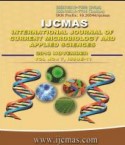


 National Academy of Agricultural Sciences (NAAS)
National Academy of Agricultural Sciences (NAAS)

|
PRINT ISSN : 2319-7692
Online ISSN : 2319-7706 Issues : 12 per year Publisher : Excellent Publishers Email : editorijcmas@gmail.com / submit@ijcmas.com Editor-in-chief: Dr.M.Prakash Index Copernicus ICV 2018: 95.39 NAAS RATING 2020: 5.38 |
An investigation was carried out at Agrometeorological field, Central Research Farm, Odisha University of Agriculture and Technology, Bhubaneswar in rabi season, 2017 in natural condition on study of various aspects of effect of weather (maximum temperature, minimum temperature, rainfall, maximum relative humidity, minimum relative humidity, wind velocity, bright sunshine hours and evaporation) on infestation of P. grisea in rice (in the varieties Khandagiri and Lalat). In rabi season among the two varieties, Lalat variety showed the higher blast incidence (2.17%) whereas Khandagiri variety showed lowest blast incidence (1.32%). The incidence of blast disease in variety Khandagiri was significant and high positively correlated with Minimum Temperature, Wind velocity, Evaporation. The blast disease incidence was positively correlated with Maximum Temperature, Minimum Relative humidity. The incidence of blast disease in variety Lalat was significant and high positively correlated with Minimum Temperature. The blast disease incidence was positively correlated with Maximum Temperature, Wind velocity, Evaporation and negatively correlated with Maximum Relative humidity. Rainfall, Minimum Relative humidity and BSH have no effect on the disease incidence. Weather parameters played a major role in disease incidence in rabi season and in this location, among the two different varieties Lalat variety is very susceptible to blast disease than Khandagiri.
 |
 |
 |
 |
 |